Excerpts from Jim Conrad's
Naturalist Newsletter
from the September 28, 2014 Newsletter issued from the Frio Canyon Nature Education Center in the valley of the Dry Frio River in northern Uvalde County, southwestern Texas, on the southern border of the Edwards Plateau; elevation ~1750m (~5750 ft); N29.62°, W99.86°; USA
SIGNALGRASS
Up against the green-painted, corrugated tin walls of an observation building at Cook's Slough Nature Park on Uvalde's south side some healthy-looking grasses were flowering and I couldn't quite place them. They're shown below:
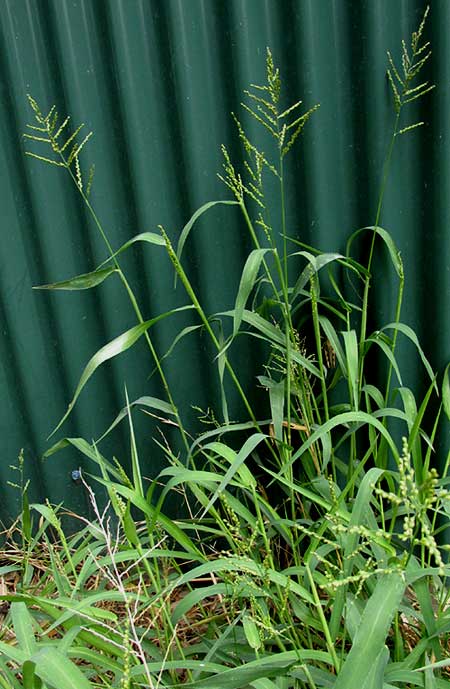
What knee-high grass with , long, wide leaves like these issues pyramid-shaped flowering heads, or inflorescences, with such straight side-branches? The general inflorescence shape reminds me of the barnyard grasses, genus Paspalum, but up close the spikelets don't look at all like Paspalum, as seen below:
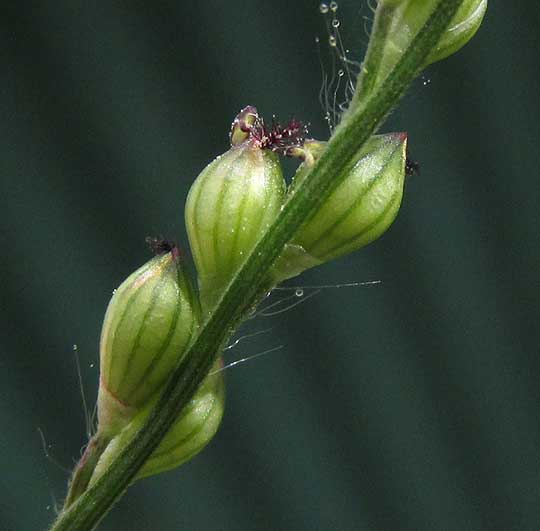
With a single grain-producing floret per spikelet, the spikelets look like those of the panic-grasses, genus Panicum. However, the manner by which the spikelets arose on only one side of the flattish inflorescence branch, or rachilla, (they're "secund") is something I don't recall seeing among the panic-grasses. Those long hairs also are good field marks worth remembering.
Deciding that either the plant was closely related to the panic-grasses or else actually a very unusual panic-grass itself, I checked the ligule -- the little wall-like thing that may or may appear where a grass blade meets the stem, and which can take many forms. This grass's ligule is shown below:
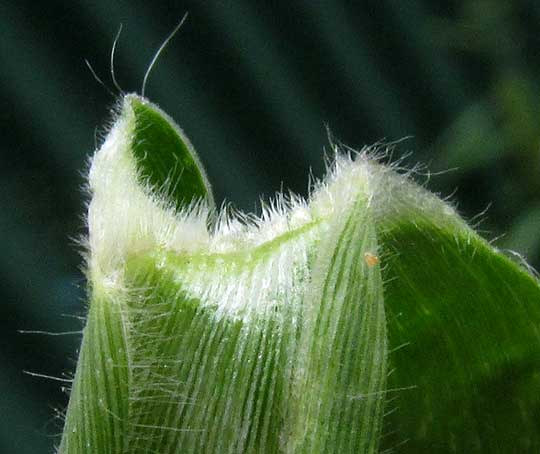
The white-hairy ligule stretching across the inside curve of this grass blade could well be that of a panic-grass, but other grass genera can have such ligules, too, so this doesn't prove much. It was just those "secund" spikelets that worried me about calling this a panic-grass.
In the end our grass turned out to be something other than a panic-grass, though very closely related. It's Browntop Signalgrass, UROCHLOA FUSCA, a mostly tropical American grass occurring from Argentina and Paraguay north through the Americas into the southern US from Arizona to Oklahoma and Florida. The "browntop" part of the common name refers to the fact that sometimes spikelets more mature than ours are deep purple-tinged. Even in our picture you can see a little purplishness developing at the spikelets' very tips. Also, in more mature spikelets, typically cross-veins connect the conspicuous green veins running from bottom to top. If you look closely you can see such cross-veins beginning to form in some places.
Browntop Signalgrass's habitat preference is described as moist, often disturbed areas at low elevations, frequently occurring as a weed, and occasionally grown for forage and grain. That fits our grass well, for I didn't see it out in the dry scrub. Moreover, I halfway suspect that someone sowed it around the observation shelter when it was built.
Worldwide, about a hundred species of the genus Urochloa are recognized, and they're all tropical or otherwise preferring warmer climes. Browntop Signalgrass is so closely related to the genus Panicum that in the past it was assigned to that genus. It's also resided in the genus Brachiaria. Really, taxonomists have had a hard time figuring out just where our plant belongs on the Phylogenetic Tree of Life.
One theory about the name signalgrass relates to those "secund" spikelets all on one side of their rachilla. They're like signal flags all pointing one way, signaling the direction the wind is blowing...
from the March 1, 2019 Newsletter issued from Rancho Regensis north of Valladolid, Yucatán, MÉXICO
SIGNALGRASS, YUCATAN STYLE
We first ran into Signalgrass, Urochloa fusca, as you can see above. This week when I met up with a similar looking grass entangled with many other weedy species along a road, I didn't realize that it was the same species. It turns out that the species is very widely distributed -- throughout the tropical and subtropical Americas, plus it's established in Australia -- and as you might expect of such a broadly distributed species, some of its features vary from region to region, especially with regard to its hairiness and spikelet size.
In fact, I've had a hard time convincing myself that our local roadside grass is just another form of Urochloa fusca. I've settled on the ID mostly by the process of eliminating other possibilities, and that's never encouraging to an identifier.
Whatever the case, below are all the field marks on our local grass I can photograph, and if anyone has a better ID for it I'd like to hear from them.
The rather lanky plant with its flowering head occupying the picture's top right corner is shown below:
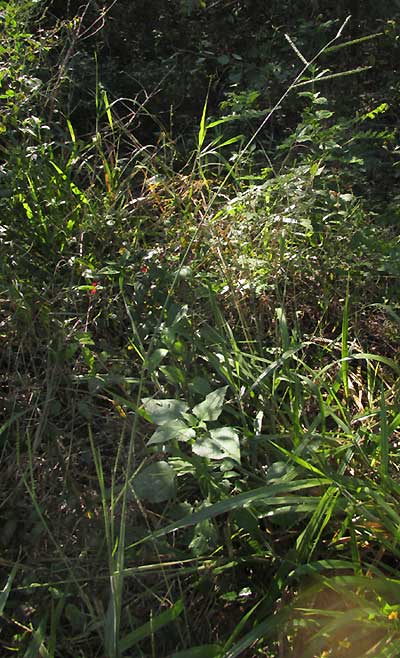
Notice that at the grass's bottom smaller shoots are emerging. Within the flowering head, a single row of spikelets is arranged along one side of a narrow rachilla heavily beset with long, sharp hairs, as seen below:
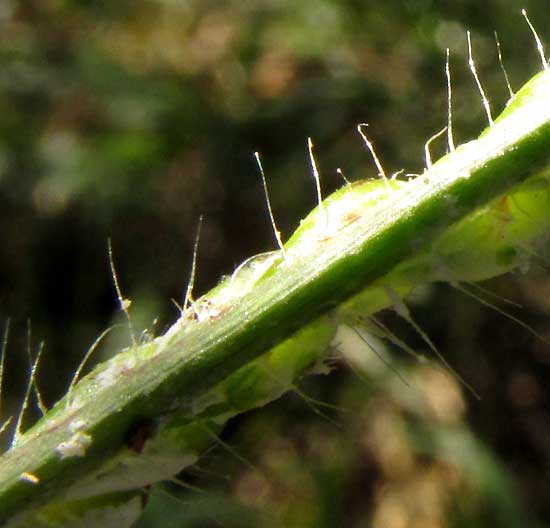
A side view showing how the spikelets line up with one another, and that the bases of many hairs are swollen, is seen below:
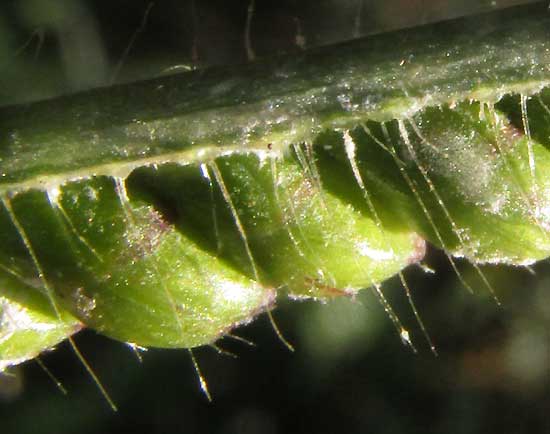
Our spikelets are a little larger than described in the literature I've seen, as seen below against a ruler's millimeter marks:
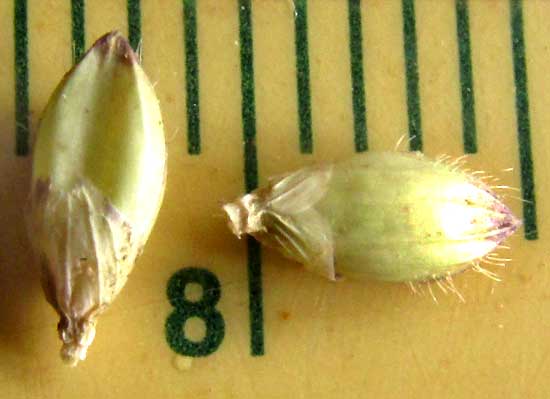
While leaf blade surfaces themselves are not so hairy, their sheathes surrounding the stems below them are densely so, as seen below in a picture also showing the ligule at a blade's base:
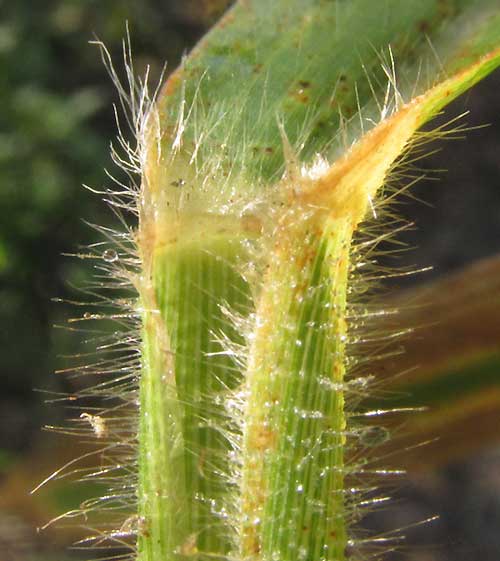
This grass's lower stems tend to run along the ground before arching upward, as indicated below:
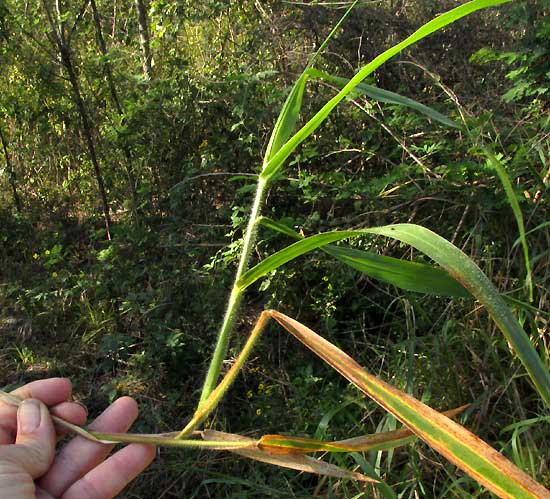
Certain nodes on the stem's ground-running part issue adventitious roots like those shown below:
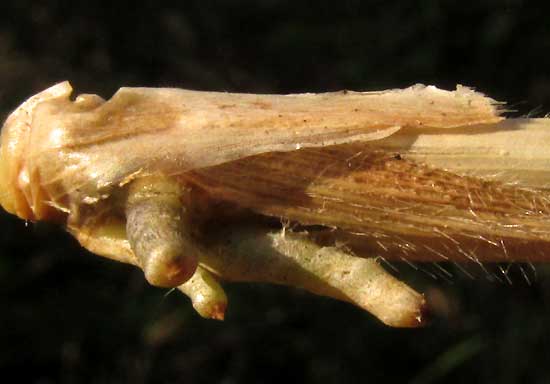
In Mexico Urochloa fusca is mostly a weedy grass, though when it occurs in pastures livestock gladly eat it. Sometimes it's even cultivated as a forage crop.